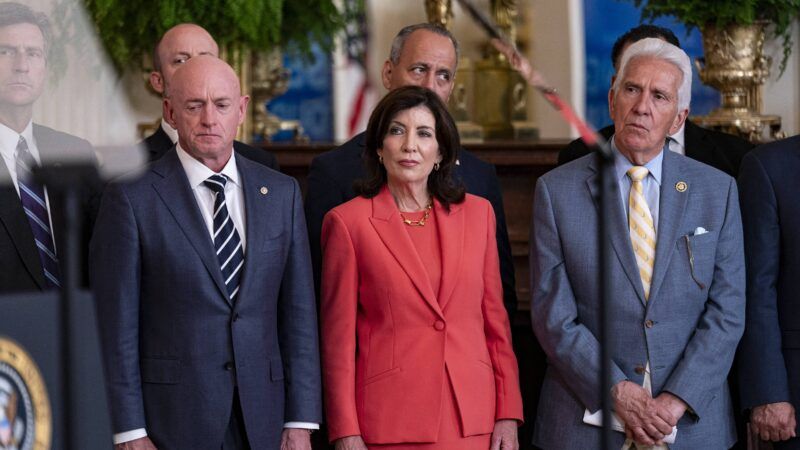New York Gov. Kathy Hochul Kills Congestion Pricing
In a surprise move, the governor axed a plan to start charging drivers $15 tolls to enter lower Manhattan starting at the end of June.

After years of public engagement, foot dragging from federal officials, and multiple obstructionist lawsuits, New York's congestion pricing plan was ready to roll. Come the end of the month, sensors and cameras were ready and waiting to charge most drivers $15 tolls for entering Midtown Manhattan and below, with the money earmarked for New York's transit system.
Today, Gov. Kathy Hochul killed the plan.
Passed by the New York Legislature in 2019, congestion pricing was "enacted in a pre-pandemic period when workers were in the office five days a week, crime was at record lows, and tourism was at record highs," said Hochul in a video announcing the policy's surprise death. Now that everything has gotten worse in the city "the planned congestion pricing system risks too many unintended consequences at this time," she said.
Technically, Hochul is indefinitely pausing the implementation of congestion pricing. The policy's supporters worry that if it can't be implemented now, it will never be.
"I'm very upset that suddenly, out of the blue, this would pop up. If we stop congestion pricing now we're never going to get it," said Sen. Liz Krueger (D–Manhattan) to The New York Times. Urbanists and transit advocates were likewise infuriated at Hochul, calling her decision a "betrayal."
Congestion pricing, whereby tolls are used to manage traffic congestion throughout the day, is at its root a good idea. Cities around the world have used it to keep traffic flowing in their central business districts. A few places in the U.S. also have congested price lanes where drivers pay dynamic tolls to travel in free-flowing lanes.
New York's planned congestion pricing scheme fell short of the best-designed congestion pricing programs. It would have charged a flat toll, limiting its effectiveness at actually reducing congestion.
The program was also primarily sold as a bailout of New York's subway system, which helped alienate drivers who'd have to pay the tolls.
"They didn't lead with, 'We're going to stabilize traffic flow and therefore benefit you as motorists,'" Marc Scribner, a transportation policy researcher at the Reason Foundation (which publishes this website), told Reason last year."You can understand the knee-jerk reaction from a lot of motorists is that this is a cash grab."
Politicians from commuter communities around New York lined up to oppose the policy. The State of New Jersey sued to stop it, as did the teachers union.
Up until yesterday, it looked like these opponents would fail to derail congestion pricing. Now Hochul has done their wet work for them.
The cash grab is now defeated. New York's traffic problems will remain.
Rent Free is a weekly newsletter from Christian Britschgi on urbanism and the fight for less regulation, more housing, more property rights, and more freedom in America's cities.


Show Comments (33)